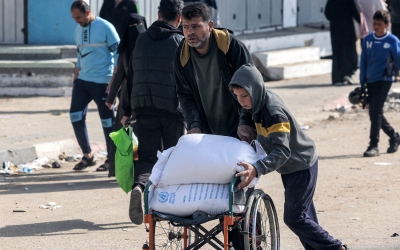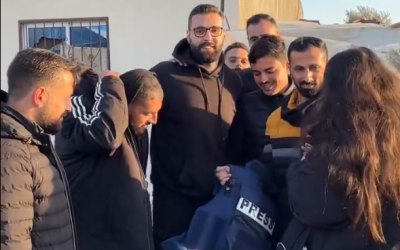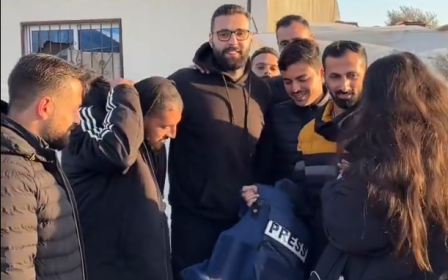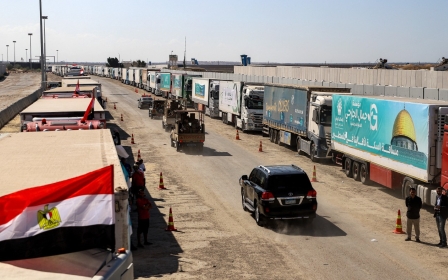War on Gaza: Israeli quadcopters, the hi-tech weapon menacing Palestinian civilians
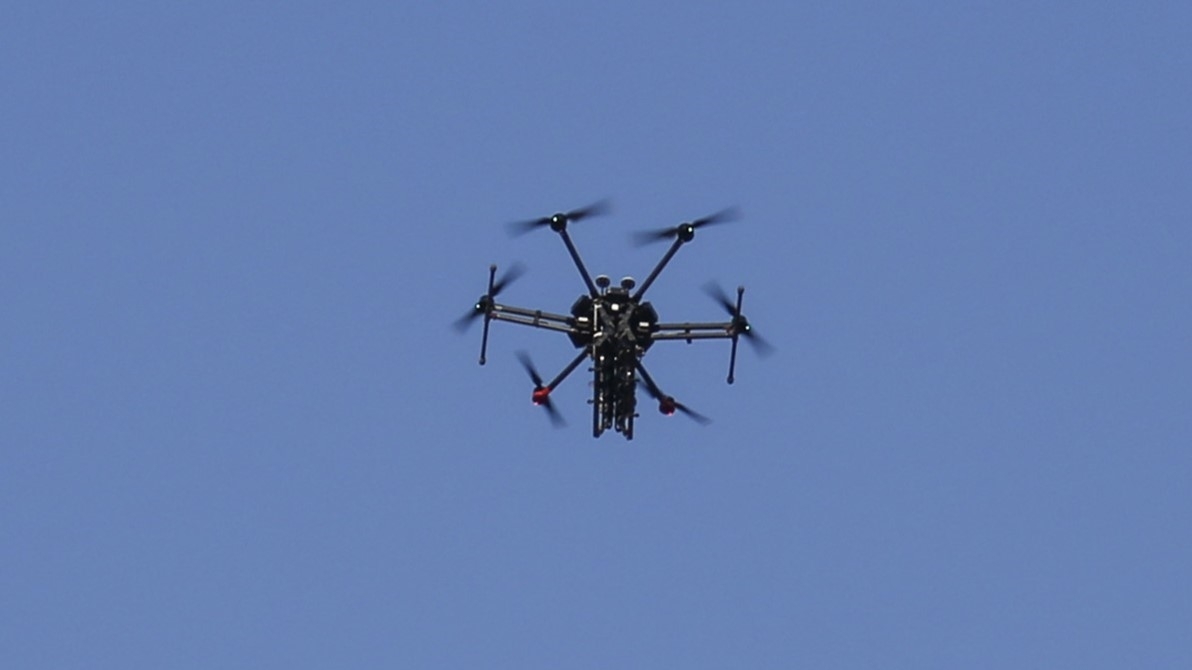
For decades, Palestinians have become accustomed to death from above.
Israel’s arsenal of aerial platforms include warplanes, such as the F16, Apache attack helicopters and combat drones.
These have been used to great effect on the urban environment in both the occupied West Bank and Gaza.
The ongoing war on Gaza, however, has brought about a new development - one used to target individuals and groups of people from close quarters.
For the first time in the Palestinian territories, remote-controlled quadcopters have been deployed on a large scale against suspected Palestinian fighters and civilians.
New MEE newsletter: Jerusalem Dispatch
Sign up to get the latest insights and analysis on Israel-Palestine, alongside Turkey Unpacked and other MEE newsletters
The technology is increasingly taking the place of soldiers on the ground and serves to identify targets, target individuals and secure areas where Israeli troops are stationed.
Quadcopters can also be used to scout forward positions, target people in their homes and disperse crowds in public areas.
The Palestinians of Gaza are now more than familiar with the weapon and the devastation it can cause.
In the months since the conflict began on 7 October, quadcopters have been used in attacks against hundreds of civilians in crowded areas, killing and injuring dozens at a time.
Al-Rasheed Street massacre
One of the most notable incidents involving the use of quadcopters was during the massacre on 11 January at Al-Rasheed street near the Gaza City coast.
Middle East Eye spoke to several witnesses, who said quadcopters opened fire on hundreds of people who had gathered there to wait for the arrival of aid trucks.
“We heard that trucks loaded with food and aid were going to pass through Al-Rasheed street,” said 42-year-old Qassem Ahmed, a resident of northern Gaza.
“Since we’ve been cut off from aid and food for around three months, we run after the aid trucks to try and get as much food as possible," he added, during a conversation with Middle East Eye.
"I left home with my 18-year-old son at around 8am. We went to Al-Rasheed Street on foot because there were no cars, and the roads were too damaged for animal-drawn carts.”
Ahmed and his son got to the area where the aid was expected at around 9am and there was already a crowd of hundreds there.
Around an hour later, before the trucks had arrived, Ahmed and the other Palestinians in the area were set upon by the Israeli military.
“We were taken by surprise by the heavy gunfire coming from above, there were quadcopters shooting directly at the crowd," he said.
"We started running in all directions. Within a few seconds, dozens of people fell and we could not stop to help or pull them up because the shooting continued."
According to eyewitnesses, more than 40 people were immediately killed and dozens others were injured in the incident.
‘Lethal payloads’
The exact models of the quadcopters used in the attack on Al-Rasheed street is not known but several variant models are known to be used by the Israeli military.
One type is called Lanius and is produced by Israeli arms manufacturer Elbit Systems.
On its website, Elbit describes the functionality of the machine:
“LANIUS is a highly manoeuvrable and versatile drone-based loitering munition designed for short-range operation in the urban environment.
“The system can autonomously scout and map buildings and points of interest for possible threats.
“LANIUS can carry lethal or non-lethal payloads, capable of performing a broad spectrum of mission profiles for special forces, military, law enforcement, and HLS [Helicopter Landing Sites].”
Some quadcopters are known to come with a “suicide” functionality, in which they can approach a target for assassination and detonate explosives onboard.
This function is believed to have been used by Israel to kill Palestinian Islamic Jihad leader Bahaa Abu al-Ata in Gaza City in November 2019.
Outside of Gaza, Israel is believed to have operated quadcopters in Lebanon and in Iran to target sites that would normally be beyond the reach of its military.
The low profile and radar signature of a quadcopter means they can bypass anti-aircraft measures normally on the lookout for larger warplanes and drones.
Remotely controlled, quadcopters require an operator who is stationed nearby (within a 50km radius). Usually the person controlling the machine will be a soldier inside an armoured vehicle or a sniper hiding in a nearby building.
Targeting civilians
In Gaza, the main reported function of quadcopters has been to menace Palestinians, who appear to be civilians in most cases.
Those Middle East Eye have spoken to say that they have seen the machines target civilians trying to evacuate areas being bombarded by the Israeli army.
Ibrahim al-Madhoud was a resident of the Sheikh Radwan neighbourhood of Gaza City, but is now a displaced person living in central Gaza.
'On our way there, on Street 10, a quadcopter shot around 15 bullets at the front of the car and made several holes in it'
- Ibrahim al-Madhoud, Gaza City
When he was evacuating his home on 16 October, he says an Israeli quadcopter targeted the taxi he was fleeing in.
“I left my home with my wife and children, and took a taxi towards central Gaza,” he recalled.
“On our way there, on Street 10, a quadcopter shot around 15 bullets at the front of the car and made several holes in it.”
Unfortunately, for Madhoud, that would not be his last encounter with the machines.
After he and his family settled in a tent in the Al-Zawaida area of Gaza, the 45-year-old father of five says an Israeli quadcopter attacked them again.
On 3 January, he noticed a quadcopter hovering above his family’s tent for around half an hour.
“It went away and then came back again, and suddenly fired two bullets at our tent while I was there with my wife and children,” he said.
“Thankfully, the shots did not hit us but made two holes in the tent.”
Akram al-Othmani, a bus driver who also lives in Al-Zawaida, said a quadcopter also attacked him while he was making his way to the area.
The 35-year-old was making his way out of his home in northern Gaza after the Israeli military dropped leaflets warning people to evacuate.
“There was a puddle on the ground and I was just about to jump over it when a bullet was fired just above my head,” he said, recounting the incident to Middle East Eye.
“An elderly woman in front of me screamed, asking ‘what’s going on son’, and I told her that I did not know.
“I looked up and saw a quadcopter only around 100 metres from me.
“It was not a regular bullet. It made a hole in the ground. I would have been killed immediately.”
Middle East Eye has contacted the Israeli military for comment on the allegations of targeting civilians using quadcopters.
‘Strong and dangerous’
Middle East Eye’s correspondent Mohammed al-Hajjar has also witnessed quadcopters firing on civilian targets.
He described the bullets fired by them as resembling a nail, adding that they are not completely accurate but still “very strong and dangerous”.
“During the 22-day-long siege on our area, quadcopters hovered above the tallest building in the neighbourhood. It shot at everything that moved and even through windows covered by curtains," he reported.
“Cats and dogs walking on the street have been shot by quadcopters and windows in our home that have been blocked with curtains have received more than 200 bullets,” he added.
'I saw four people get killed by quadcopters and one of them was left on the ground for five or six days'
- Mohammed al-Hajjar, correspondent
“Israeli forces fear that (resistance fighters) might be hiding behind the curtains so try to secure the area by shooting through them.”
Hajjar describes the streets of Gaza City as being strewn with the bodies of Palestinians who have been killed by quadcopters.
In some cases, the bodies remain there for days as anyone who tries to retrieve them risks being shot themselves.
“I saw four people get killed by quadcopters and one of them was left on the ground for five or six days because no one could retrieve his body,” Hajjar said.
“Quadcopters hover all over the place and it's dangerous for us to leave our home,” he added.
The presence of the machines is so pervasive that Palestinians have even figured out the ammunition capacity of a typical quadcopter.
"A quadcopter is usually loaded with around 64 shots and all the 64 can be shot (quickly) when there is a target," Hajjar said.
This article is available in French on Middle East Eye French edition.
Middle East Eye delivers independent and unrivalled coverage and analysis of the Middle East, North Africa and beyond. To learn more about republishing this content and the associated fees, please fill out this form. More about MEE can be found here.


